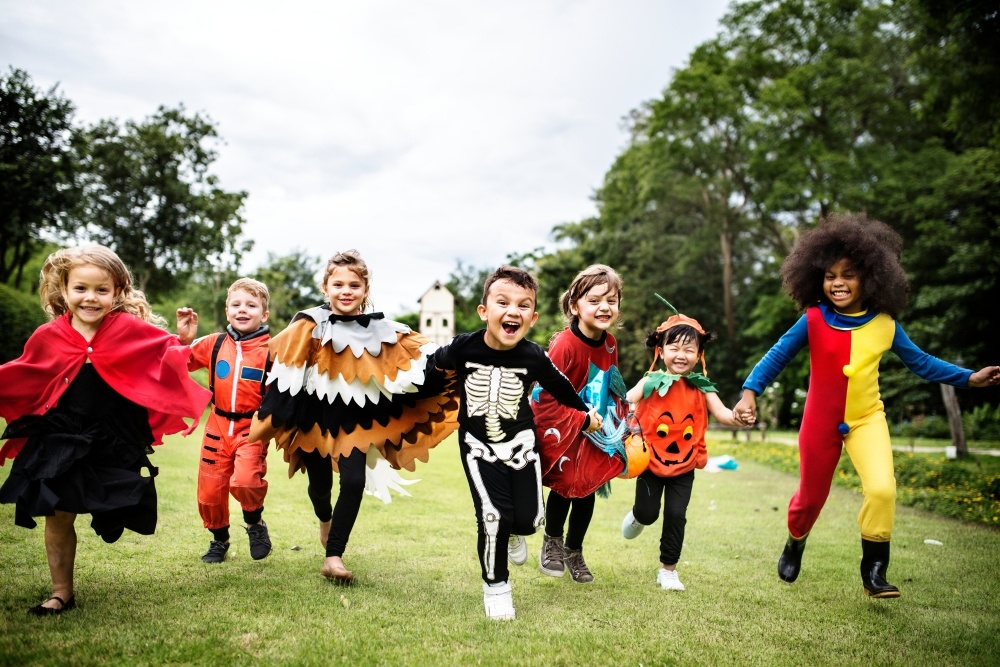You won’t find Halloween on the official liturgical calendar of the Church; the holiday has its roots in the popular piety of past centuries (not in ancient pagan practices, as is sometimes claimed). Back then, the celebration was all about remembering the dead and confronting the reality of death and evil in the world. The full meaning of the holiday was always realized in light of the next day’s celebration, the Feast of All Saints—the triumph of God’s people, and the victory of light over darkness.
The dark side of Halloween
These days, some devout Christians avoid the holiday because of the way the original meaning has been lost or corrupted (much like the celebration of Christmas). They’re rightly uncomfortable with the way some people push the gore, fright, and sex factor over the top—not to mention the way modern pagans have taken the holiday as their own. But as Fr. Steve Grunow argues in It’s Time for Catholics to Embrace Halloween, the origins of Halloween belong to the Church, and it is entirely appropriate for the Church to “clarify” the holiday.
Celebrating Halloween the Catholic way
What does that mean for Catholic parents? Perhaps the best approach is to celebrate the holiday as a way of confronting the reality of sin, death, and darkness in the world, while affirming that darkness and death do not have the final word.
For young children, there’s another important dimension of Halloween that’s worth affirming: pretending to be someone else—someone stronger, more powerful, or more grown up than themselves. This isn’t necessarily a bad thing, especially if you can gently guide them toward thinking about their ultimate identity: they are children of God, called to goodness and greatness through their relationship with Jesus Christ. You might express that idea with words like these: “You’re going to make a great [fill in the blank: princess, Jedi, fireman, etc.]. What do you like best about being that? You know, I’ll bet God could really use a good [Jedi knight, princess, fireman, etc.]. What can someone like that do for God?”
And of course, for kids the holiday is also about going out after dark with flashlights, having a few fun scares—and getting lots of candy.
10 ways to celebrate the victory of light over darkness
You can have your candy (and fun scares) and celebrate the victory of grace over evil, too, with these simple ideas:
- Collect canned food for your local food shelf. (It might help to hand out flyers in advance.)
- Participate in the Teal Pumpkin Project; put out a teal pumpkin and hand out food-allergy-safe treats.
- Donate gently used costumes to a local thrift store for families on a budget.
- Hand out saint cards or other tokens of your faith (ask if they want one first) to trick-or-treaters…in addition to the usual treats, of course.
- Bless your little ones with holy water before they go out to their Halloween celebrations, and pray the St. Michael Prayer. Explain (briefly) that they never need to be scared because God is on their side, triumphing over darkness and evil.
- Your kids might want to carve traditional jack o’lanterns, but you might also challenge them to try some designs that reflect the triumph of grace over the darkness and evil of the world. If you use a paper template to guide your carving, then the design possibilities are endless. The Sacred Heart of Jesus, the Holy Spirit descending as a dove, crosses, angels, even the profiles of saints . . . if you can find a picture of it (or even a coloring page), you can trace it onto your pumpkin by pricking an outline through the paper with a pin or sharp knife.
- Make your kids homemade paper lanterns to take out trick-or-treating; use an LED candle, search online for “homemade Halloween lanterns,” or check out the Saint-O-Lanterns at Shower of Roses.
- Speaking of Shower of Roses, head over there if you really want to kick up the Catholic in your Halloween. Scroll to the bottom of the October page for a wealth of party and celebration ideas.
- Pray for the dead! It’s traditional to pray for the dead, and especially the poor souls in purgatory, around All Saints Day and All Souls Day. If possible, visit your parish graveyard to pray for the people buried there, and all the dead. The Book of Blessings contains a ritual for visiting a cemetery; you can find an adapted version in Catholic Household Blessings and Prayers.
- Have an All Saints Party! See 7 Ideas for the Best All Saints Party Ever for details. This fun book is available for order too!



